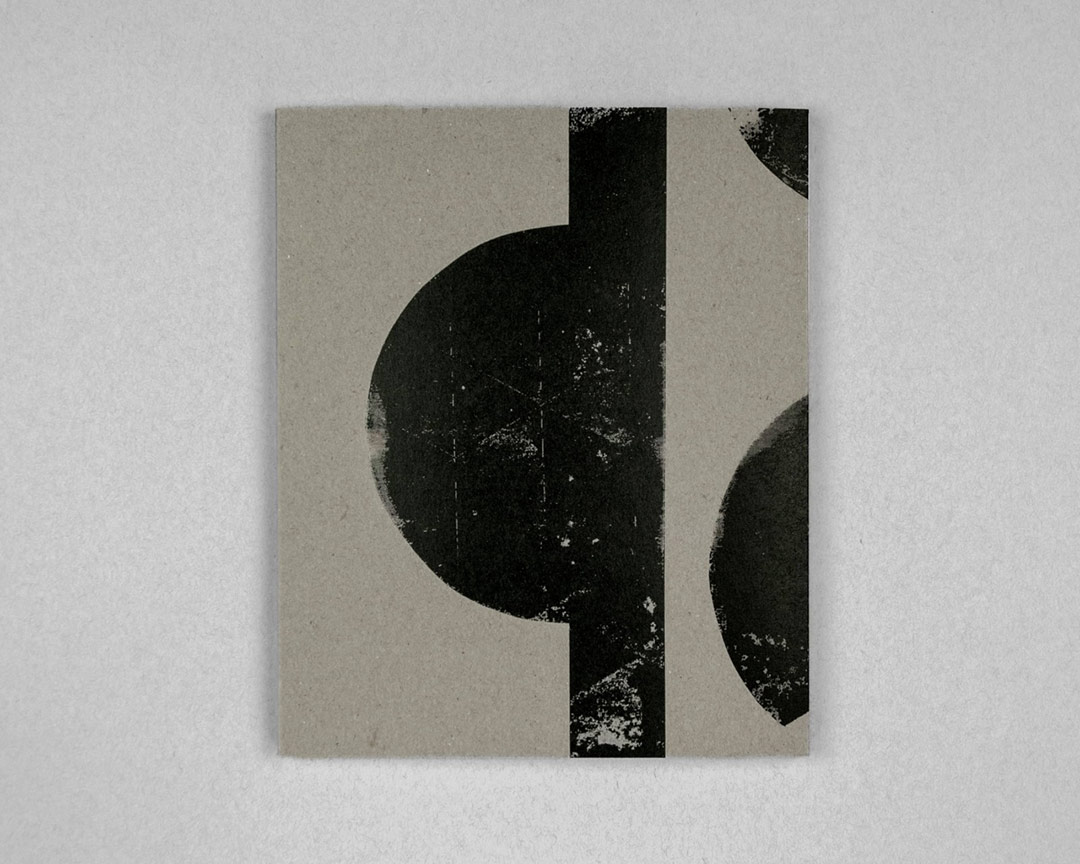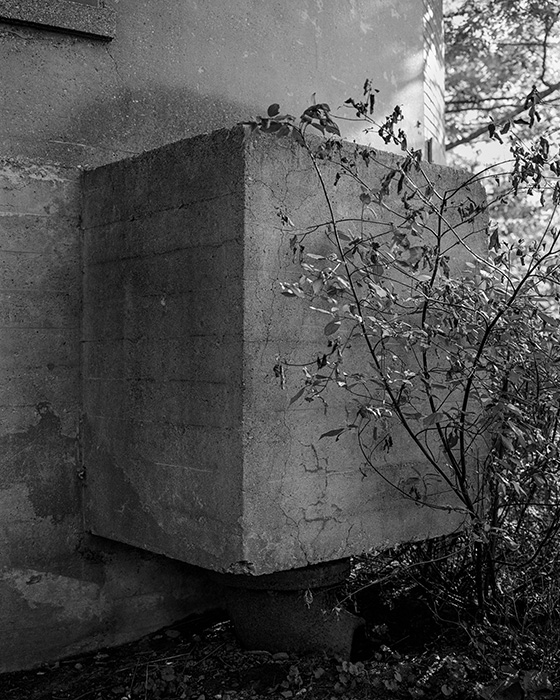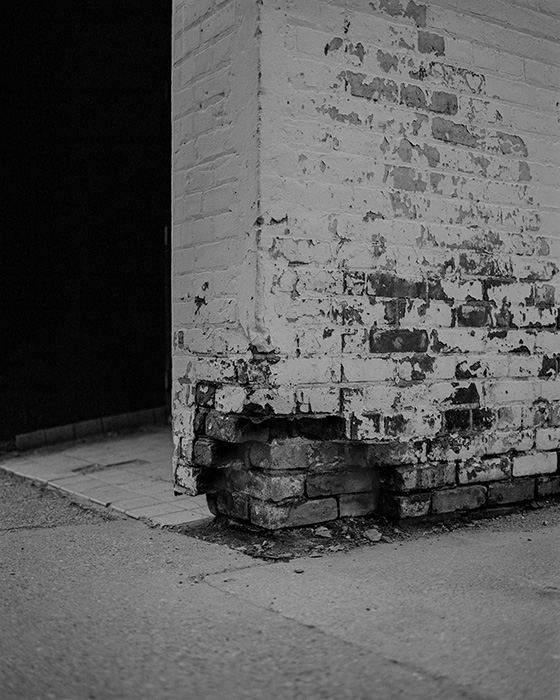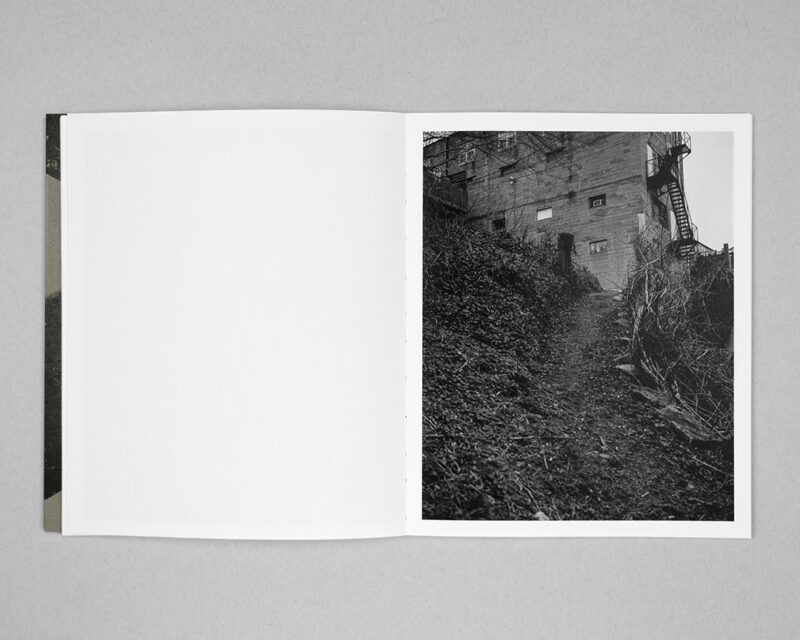[June 22, 2023]
By Louis Perreault
Frequency opens, paradoxically, on an image of a closed door, blocked with weathered plywood and fixed in an indefinable temporality. As it does in the photographs that will follow, the diffuse light drops a blanket of silence, pausing the tenacious urban soundtrack. Subtle variations in the omnipresent greys further accentuate this sense of seeing a stilled, forgotten world, with only a few discrete signs of nature evoking a gradual transformation to come.

Cristian Ordóñez, Frequency, Toronto, self-published, 2023, 72 p., 22 x 27 cm, soft cover, exposed sewn binding
The second photograph in the book is more explicit: we see a piece of concrete being absorbed by a tree’s unrelenting bark, leading us to believe that, slowly and unimpeded, the tree has taken over a now-unmovable structure. What is happening that this built world, constructed by and for human beings, seems suddenly removed from the turmoil of history? No text or citation helps with interpretation, so what is left is simply patient observation of the visual signs occupying each of the forty-six photographs as we reconstruct Cristian Ordóñez’s subdued, uncluttered world.
Ordóñez proposes a meditative stroll, stopping to gaze here at pavement cracked by repeated seasonal freeze-and-thaw cycles, there at a concrete wall with a long, fine fissure running across it. Humidity seems to escape from this fissure, encouraging the growth of plants seeking to take their rightful place in the city. Throughout the book, these blackened, split, worn surfaces are reminders of the slow and continual erosion of all things, whether they look immutable and indestructible or fragile and temporary. Ordóñez invites us to look at the world both as it may have been in the past and as it will become once our brief passage through these landscapes is a distant, fleeting memory.
In the far background are a few dwellings that also seem deserted. We can infer from the distance that separates us from these buildings both Ordóñez’s sense of discretion and his deference toward the forgotten places that he seems to be enamoured with. In the privacy of backyards and empty lots, he finds visual materials with which he writes a story, for which one can easily imagine a soundtrack heavy on the bass frequencies, conveying with sound what the gaze has already sized up in the tonal density that is generally – and obviously deliberately – darkened. In fact, visitors to Ordóñez’s website will find a fascinating audio track composed by the artist Justin Pape and presented alongside Ordóñez’s photographic installation exhibited in Santiago, Chile, in 2022.1 The soundtrack makes the reading especially captivating: it projects us into a phenomenological experience of the landscape and compels us to imagine feeling the fresh air of autumn landscapes or the humidity of water-soaked land in the spring.
Although the photographic sequence is composed mainly of details from the built environment, the presence of persistent nature stands out – first in discreet manifestations (grass between the asphalt cracks, for example), and then in images in which it has completely invaded the site depicted. The resilience of a tree trunk, twisted by some unknown phenomenon or force; an urban grove smothered by vines and high grasses; a dense forest into which the long stalk of a tentacular tree creeps; a stump blanketed with twigs: in the sequence of images, each of these organic, entangled outbursts offers a counterpoint to crumbling bricks, twisted metal, and flaking paint. In the book’s last image, it is difficult not to anthropomorphize the long branch clinging to a tree trunk as though it wanted to hold it back, photographed from a low angle – symbolizing, perhaps, humanity losing its landmarks, retaining what it can of its connection with the world of the living.
Frequency offers a clear and sensitive gaze at the world, now and to come, embodied in an elegant presentation that demonstrates an undeniable understanding of the graphic and conceptual strategies that encapsulate the creative potential of the photobook. It is not surprising that the book has already received several awards, including the Burtynsky Grant, presented during the Scotiabank CONTACT Photography Festival in 2021, to be used specifically for production of a photobook. This self-published book adds to an impressive list of experimentally oriented publications by Ordóñez, a prolific photographer and well-regarded graphic designer.2 Here, he has produced an accomplished work that deserves wide distribution. Translated by Käthe Roth.
2 Ordóñez has been the graphic designer and artistic director for several photoooks, included those published by Another Earth, a distribution platform that he created with the artists Abbey Meaker and Estefania Puerta. He also designed Betty Bogaert’s book (La montagne qui hurle, 2021, self-published, https://cielvariable.ca) and we are anticipating Hua Jin’s book, to be launched soon (Dundee, 2023, VU, Centre de diffusion et de production de la photographie). Both of these books are the result of a collaboration between Ordóñez and the respective author.
Louis Perreault lives and works in Montreal. His practice is deployed within his personal photographic projects and in publishing projects to which he contributes through Éditions du Renard, which he founded in 2012. He teaches photography at Cégep André-Laurendeau and is a regular contributor to Ciel variable, for which he reviews recently published photobooks.










